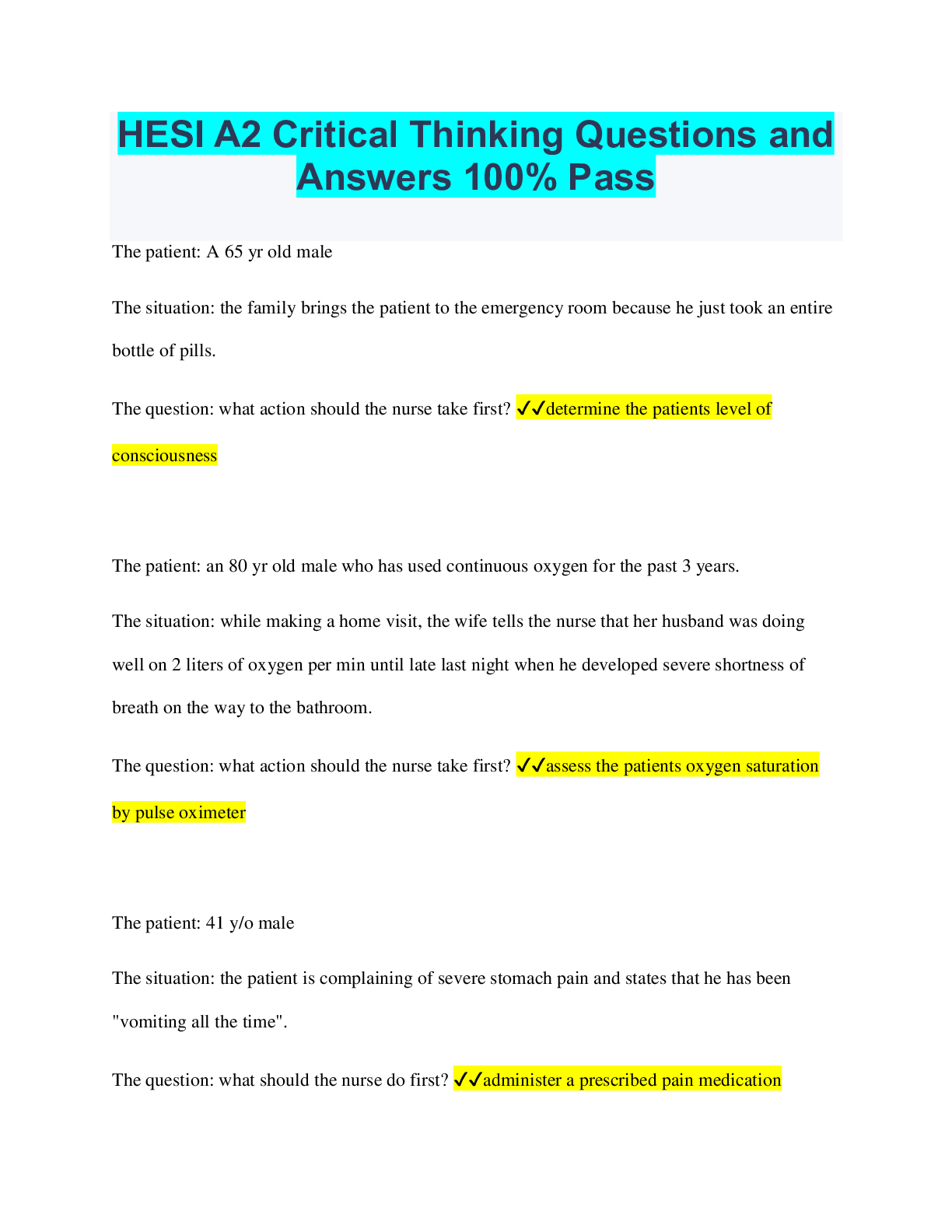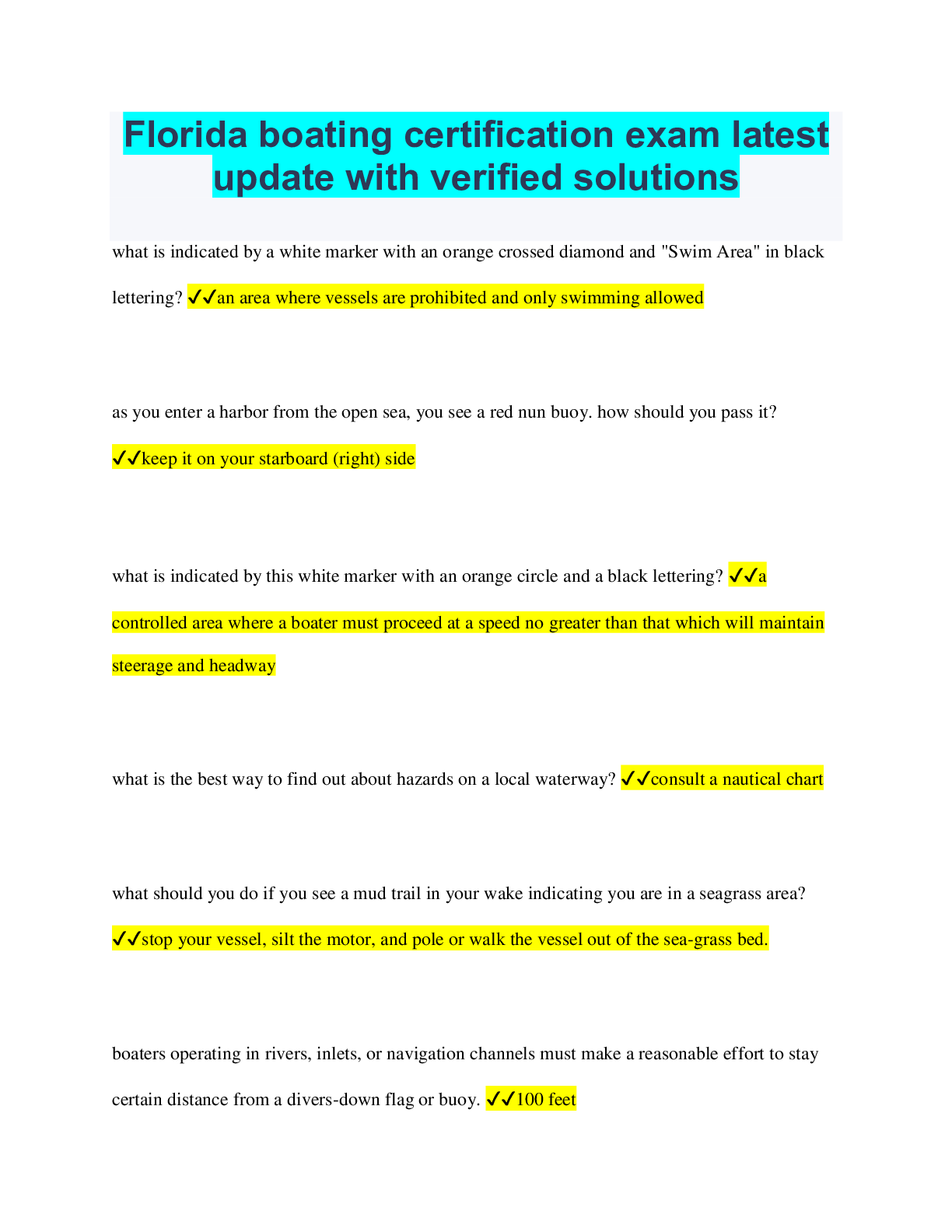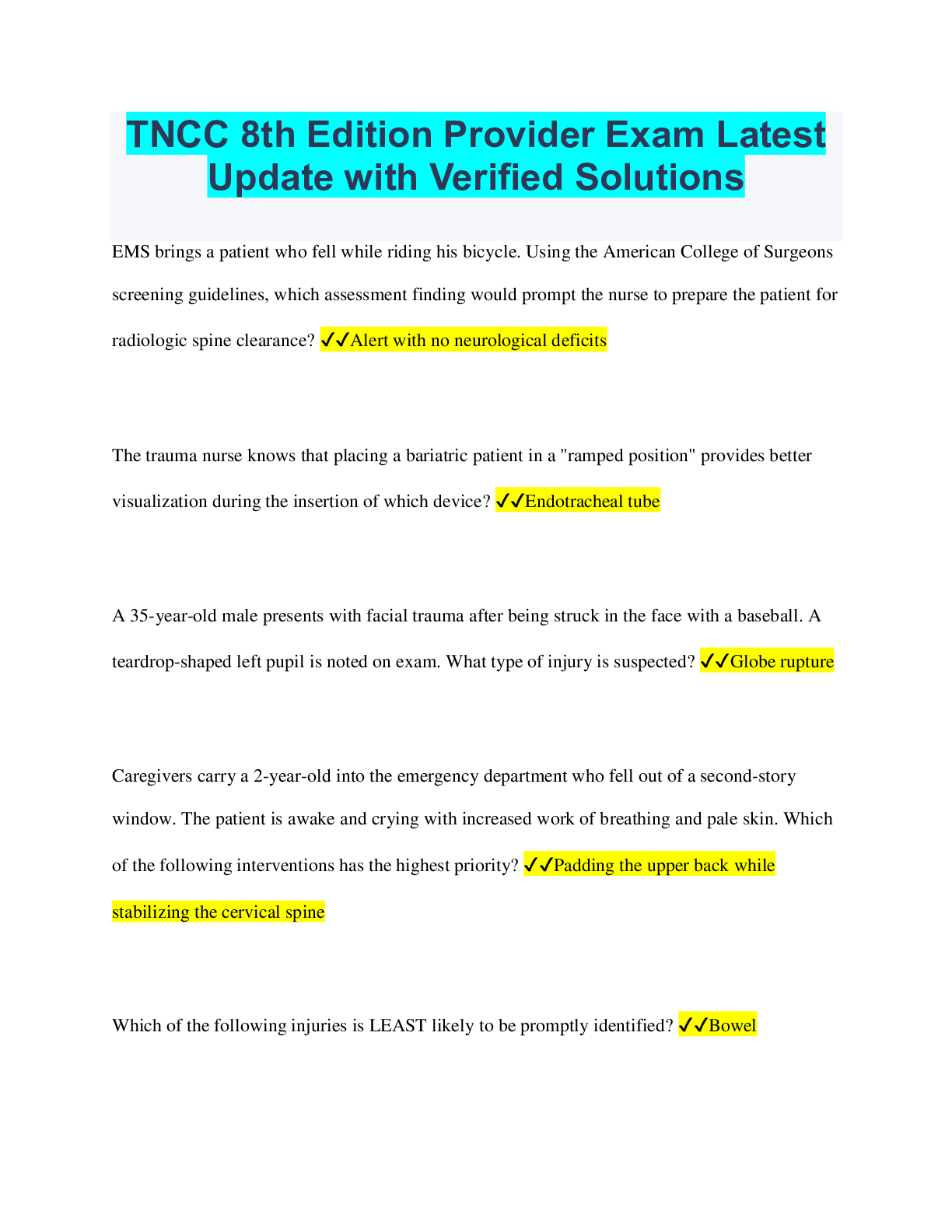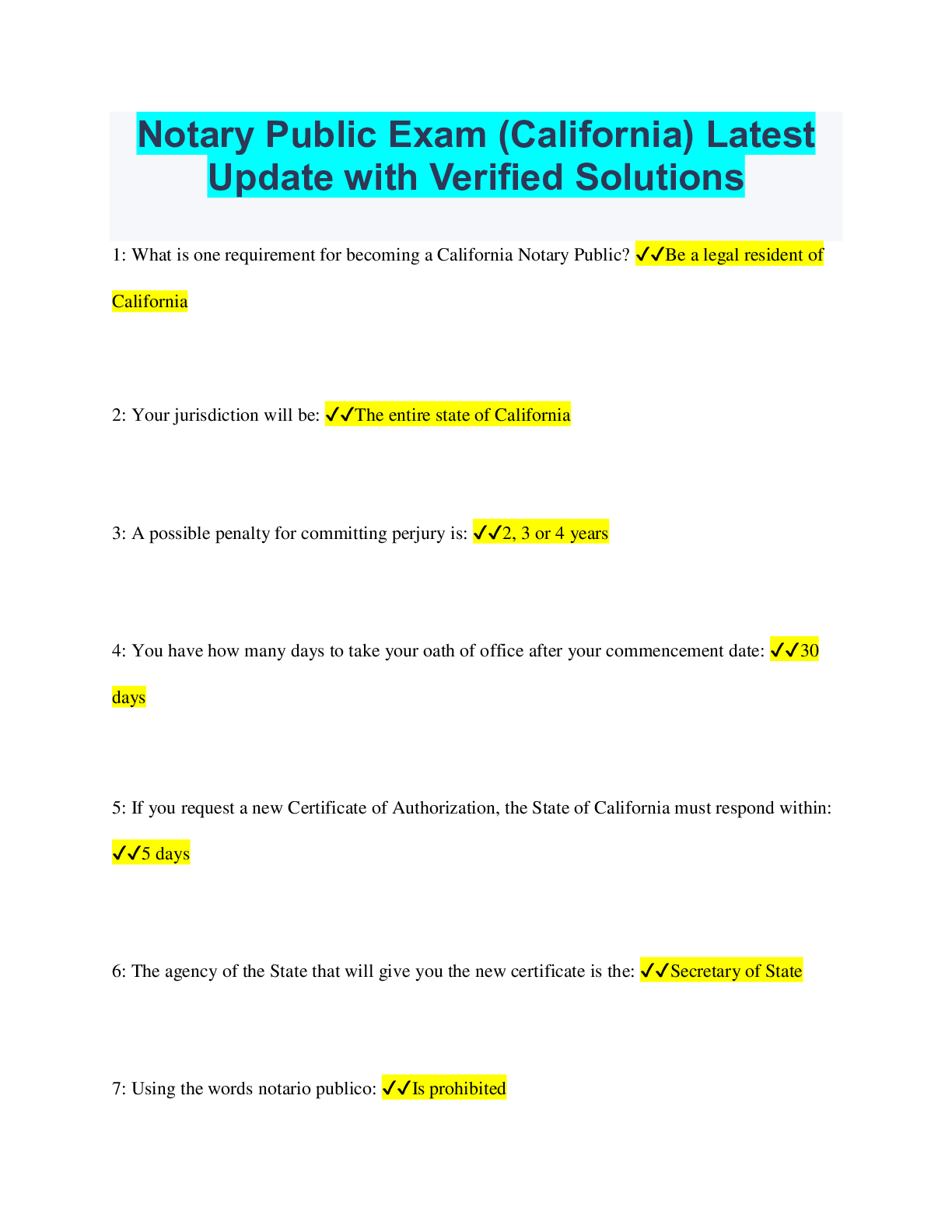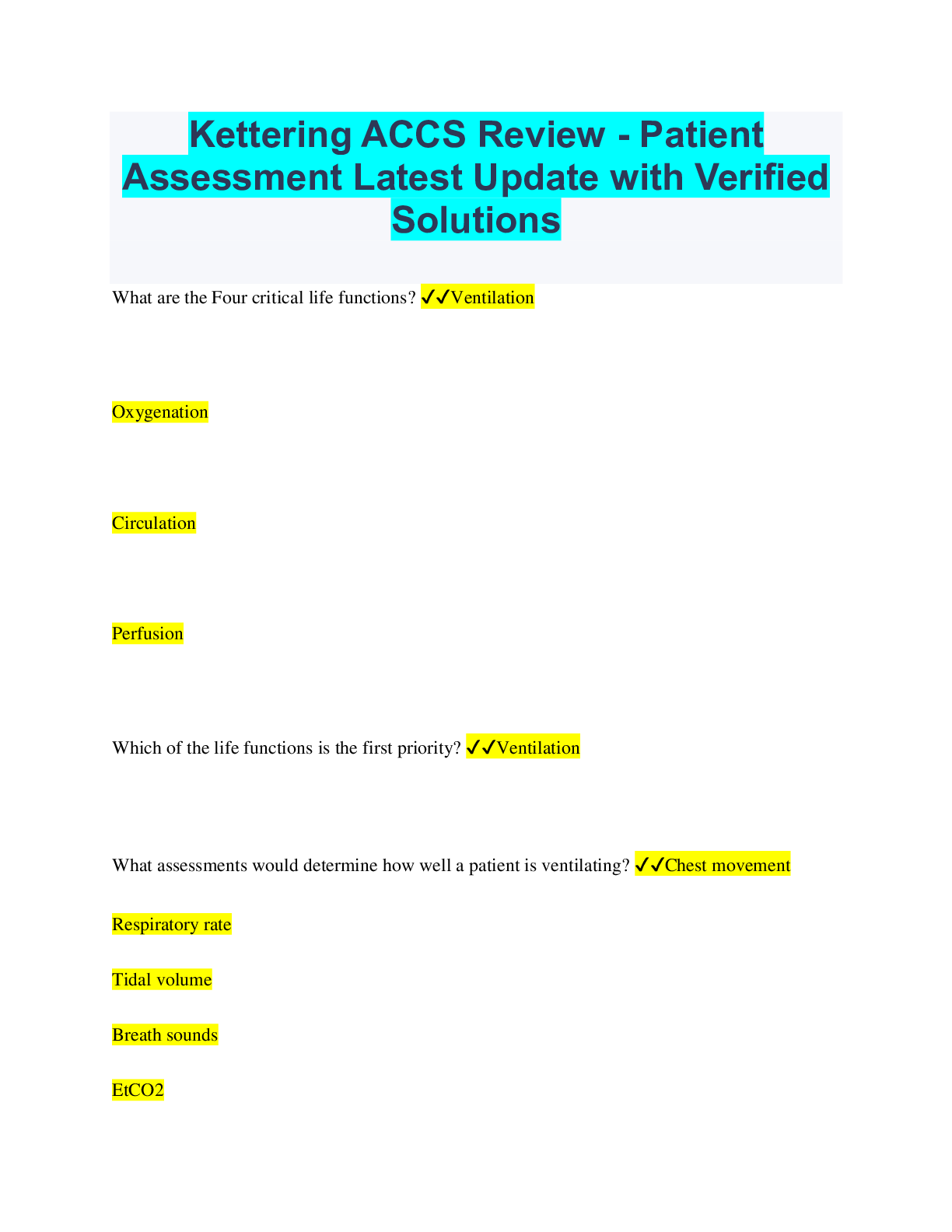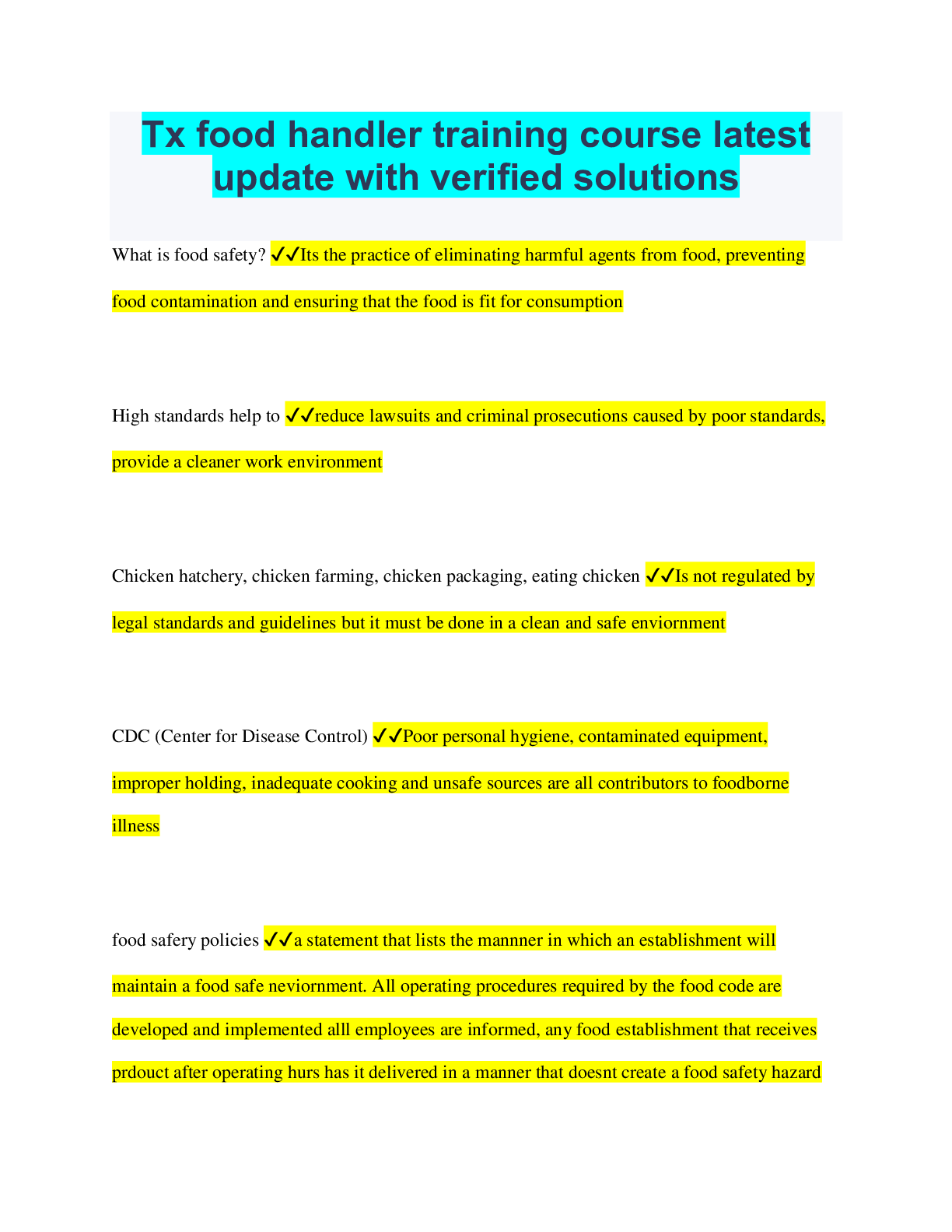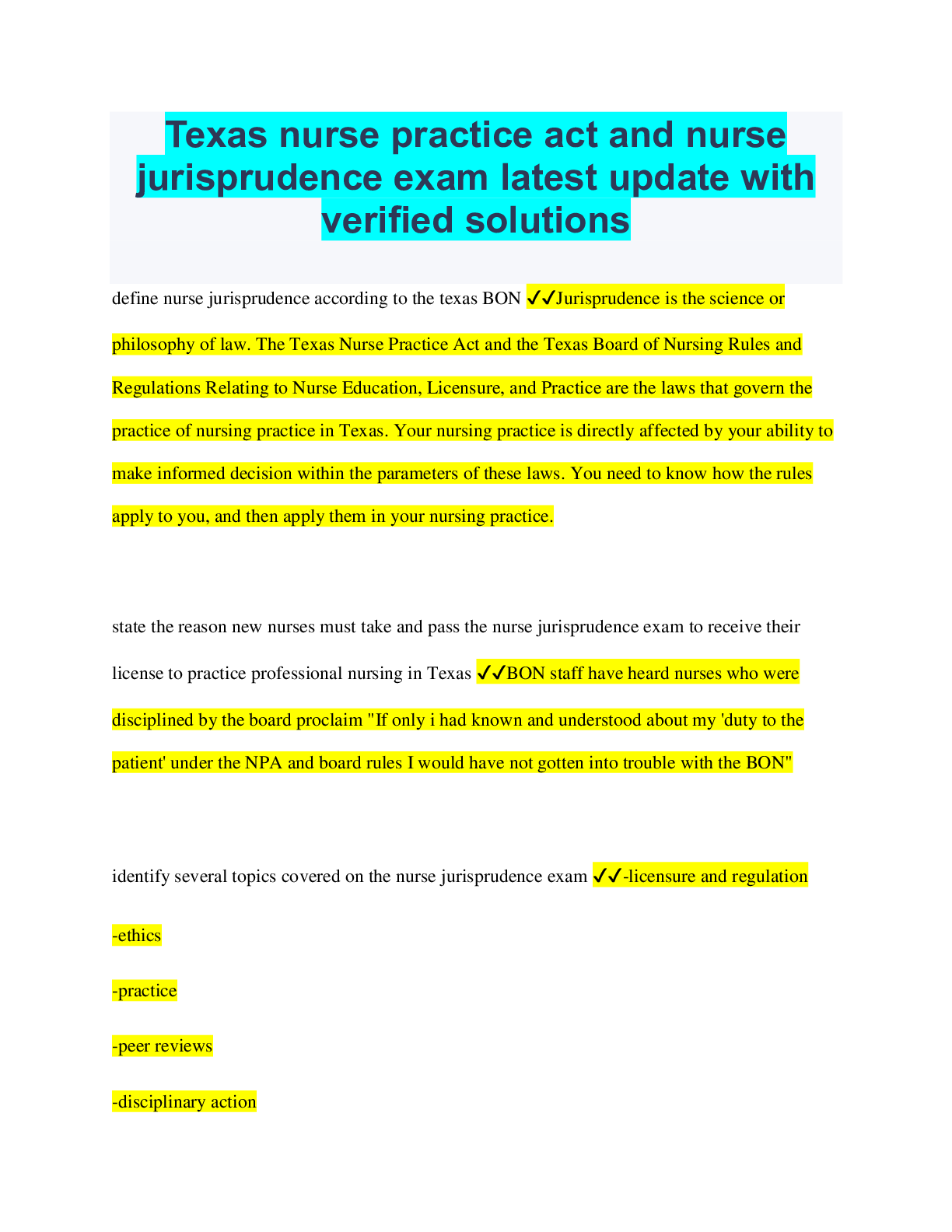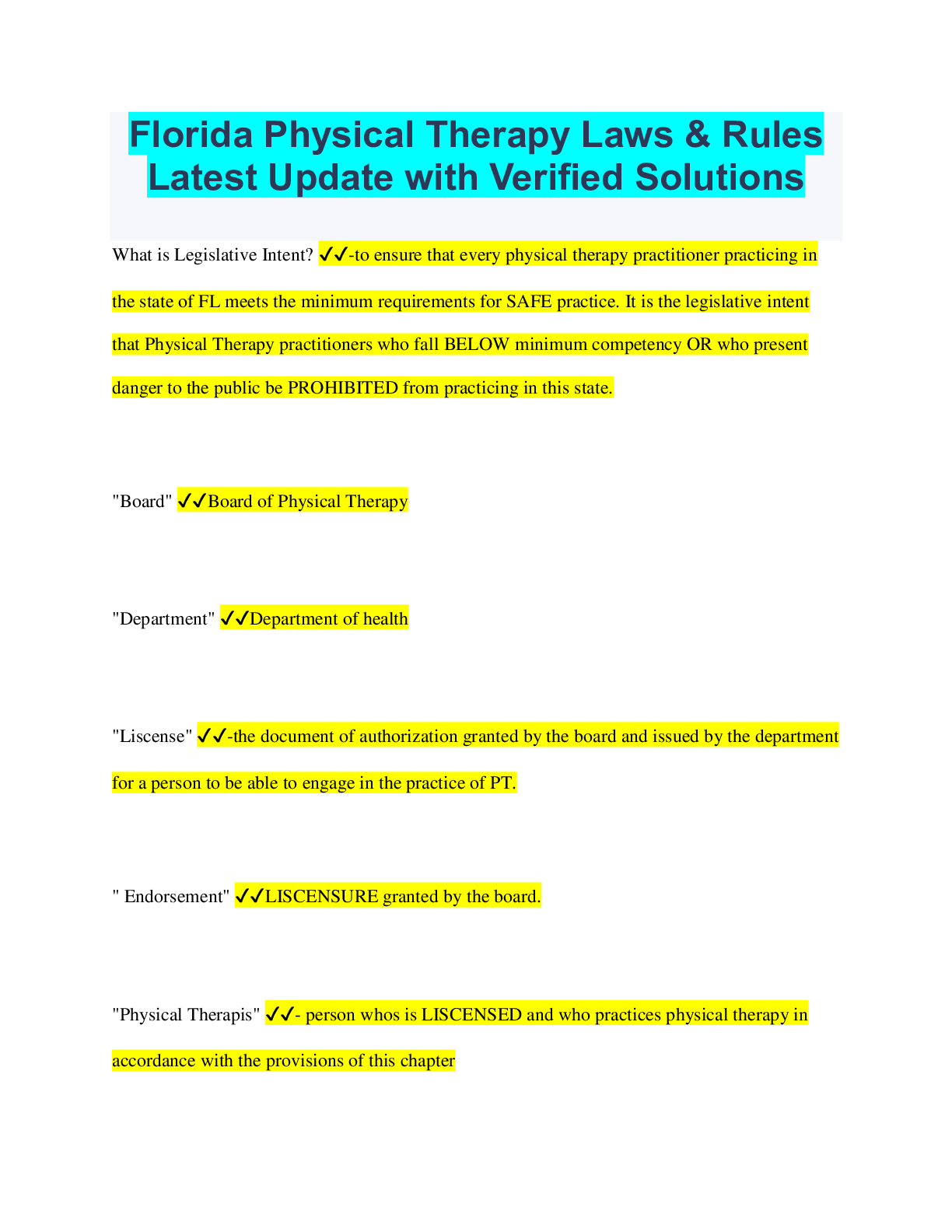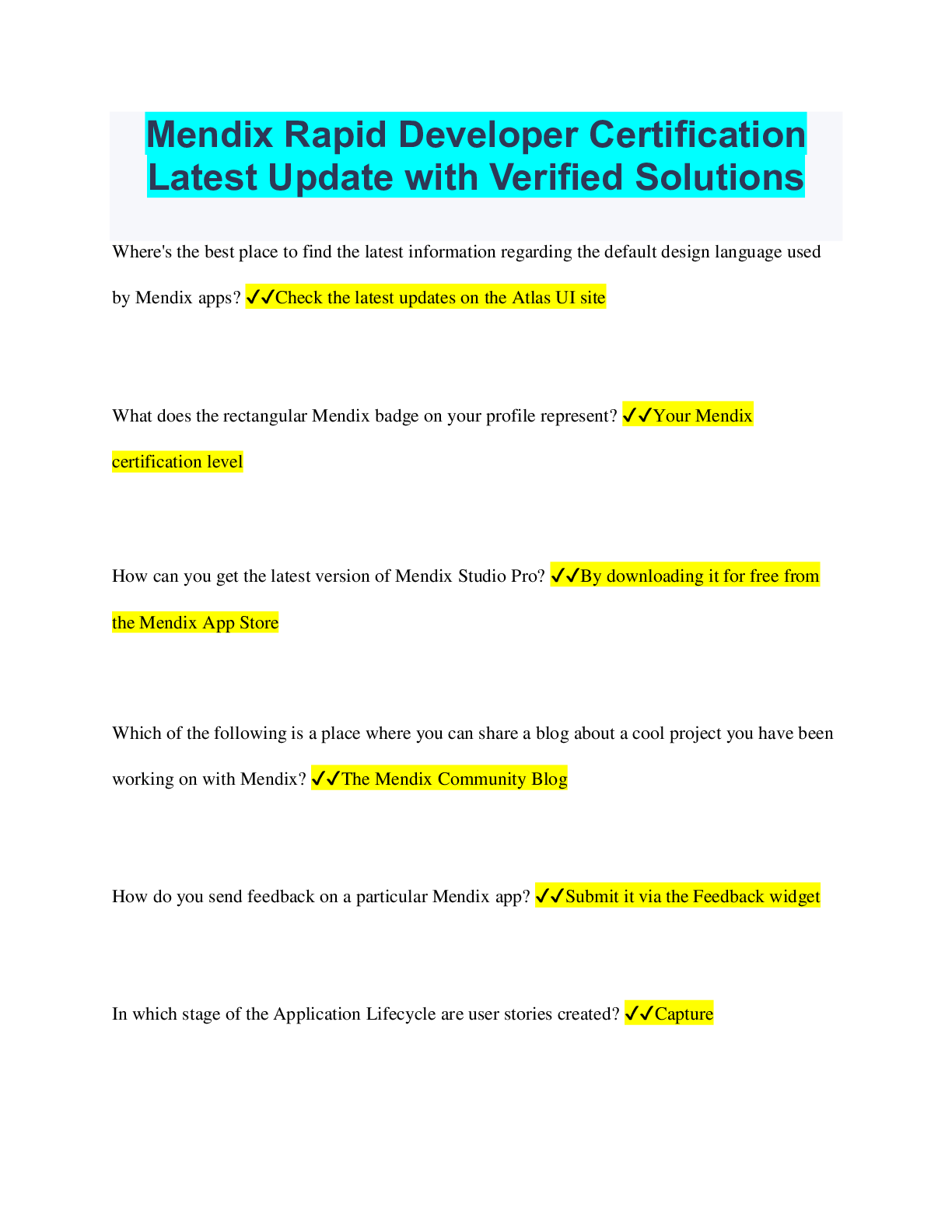Social Sciences > QUESTIONS & ANSWERS > Study guide for QMA Latest Update with Verified Solutions (All)
Study guide for QMA Latest Update with Verified Solutions
Document Content and Description Below
Study guide for QMA Latest Update with Verified Solutions Tasks the QMA is PROHIBITED from performing. ✔✔Assess a resident's condition. Call a physician. Take a physician's written or verbal or... der. Administer medication by injection. Administer any medication inhalation treatment OTHER than a metered dose inhaler. Administer medication per nasogastric tube. Instill irrigation fluids of any type including, but not limited to, colostomy, catheter and enema, EXCEPT a commercially packed prepared disposable enema. Administer a treatment that involves an advanced skin condition, including Stage II, III, and IV decubitus ulcers. The QMA Scope of Practice ✔✔Observe and report to licensed nurse. Measure and document vital signs. Administer regularly prescribed meds which the QMA has been trained to administer only after personally preparing the meds to be administered. Initiate oxygen per nasal cannula or non sealing mask only in an emergency. Obtain oxygen saturation using oximeter. Administer, apply physician ordered oral, ophthalmic, otic, nasal, vaginal and rectal meds. Crush and administer meds if such preparation is appropriate per manufacturer or physicians order. Alter capsules if prescribed to be administered in this altered manner by the physician. Count, administer, and document controlled substances. Administer meds per G-tube or J-tube. Administer previously ordered PRN meds only if authorization is obtained, then the QMA must chart resident symptoms indicating the need for the med and time symptoms occurred, Chart that the facility nurse was notified the symptoms of the resident and that permission was granted to administer med, obtain permission each time the resident needs the med, ensure that the resident's record is soigné do by the LPN or RN who gave the permission for the PRN meds. Apply topical meds to minor skin conditions such as dermatitis, scabies, pediculosis, fungal infection, psoriasis, eczema, first degree burn, stage I decubitus ulcer. Administer meds via metered dose inhaler. Conduct hemoccult testing and report result to licensed nurse. Provide site care and apply dressing to a healed G-tube or J-tube site (ordered). Empty and change colostomy bag. Instill a commercially disposable enema (120 ml or 4.5 ozs) after the resident has been assessed by the nurse. Administer a sitz bath if ordered by a physician. Apply cold, dry compress as directed by nurse or physician. Conduct diabetic urine testing. Collect fecal or urine specimens as ordered by physician. CHART CHART CHART anything the QMA see, hears, or smells and document what is reported to the Q by the resident. Negligence ✔✔The omission or neglect of any reasonable precaution, care or action. Residents are protected from health care negligence or malpractice by a law called Duty of Care. Malpractice ✔✔Any improper or injurious practice, or any unskillful or faulty medical or surgical treatment. The Six Rights of Medication administration ✔✔Right Medication. Right Dose. Right Resident. Right Route. Right Time. (1hr before or 1 hr after). Right documentation. Initial Steps ✔✔Obtain info from licensed nurse about resident's needs abilities, limitations, and known allergies. Gather supplies and equipment. Knock on resident's door. Identify yourself. Explain procedure to the resident. Wash your hands or use antiseptic foam or gel. Wear gloves to maintain Standard Precautions as necessary. Final Steps ✔✔Observe resident for any immediate reaction to med or procedure. Assure the resident is in a comfortable position. Make sure call light is within resident's reach. Remove supplies and discard of medication cups/disposable supplies. Thank resident. Remove gloves. Wash hands. Document meds administered or procedure preformed. Report any abnormalities to the nurse. Sundowning ✔✔Increased confusion and restlessness in late afternoon, evening, and night. Hand washing ✔✔Lather all areas of hands and wrists, rubbing vigorously for at least 10 seconds. Putting on Gloves ✔✔Remove one glove by grasping the outer surface just below the cuff with the other gloved hand. Isolation Precautions ✔✔Airborne-pathogens are transmitted on dust particles in air currents examples are TB, chickenpox, measles. Droplet-pathogens are transmitted in droplets when a person coughs, sneezes or talks examples pneumonia, influenza, scarlet fever. Contact-pathogens are transmitted by direct contact (skin-to-skin) with the resident or indirect contact with surfaces or care items in the resident's environment examples scabies, conjunctivitis, impetigo. Hepatitis ✔✔Contagious disease of the liver caused by a virus and spread by exposure to infected blood, sexual contact or fecal/oral contact. Symptoms are flu like. Severe infection can cause permanent liver damage and death. Types A, B, C, D, E Tuberculosis ✔✔Chronic bacterial infection that usually affects the lung but may affect other parts of the body such as the kidneys, bones, and the brain. TB is spread through the air in droplets from sputum of persons with active disease. Symptoms include fever, loss of appetite, fatigue, productive cough and night sweats. Acquired ImmuneDeficiency Syndrome ✔✔Results from infection with the Human Immunodeficiency Virus (HIV) which destroys the body's ability to fight infection. Virus is spread thru infected blood and body fluid. Early symptoms are flu like followed by a symptom free period which can last many years (one to ten or more). No cure is known, however, new meds and treatments show promise. Methicillin Resistant Staphylococcus Aureus (MRSA) ✔✔Bacteria that no longer responds to antibiotics normally used to treat staphylococcal infections. It is spread on the hands of health care workers. To prevent spread follow Standard Precautions. Vancomycin Resistant Enterococcus (VRE) ✔✔Bacteria that no longer responds to the antibiotic Vancomycin. It is spread on the hands of health care workers. Use Standard Precautions to prevent spreading. Body Mechanics/Resident Safety ✔✔Place a pillow against the headboard when moving a resident up in bed. Stomatitis ✔✔Inflammation of the mouth. Residents who have stomatitis must receive more frequent mouth care and removal of excess mucous from the mouth. Pruritus ✔✔Severe itching without evidence of a rash on the skin. It may occur over the entire body. Residents who have pruritus must have proper positioning and good skin care. Pharmacology ✔✔The study of medications and their effect on the body. Trade or Brand name of meds ✔✔First letter is capatilized. Identified with the symbol ® which indicates the name is registered or patented by a company or individual. Generic name of meds ✔✔First letter is lowercase. This is the OFFICIAL name of the medication. Usually a combination of chemicals in the medication, not patented. Body mechanics/resident safety ✔✔Place a pillow against the headboard when,living a resident up in bed. Semi synthetic combination of man made and plants, animals or minerals ✔✔Examples-Tylox (acetaminophen and opium) Local effect ✔✔Limited to the area of the body where the medication is applied. Systemic effect ✔✔Affects the entire body Tolerance ✔✔The body becomes increasingly resistant to a drug or other substance through continued exposure to the substance. Primary effect ✔✔The reason the medication was ordered. Secondary effect ✔✔Any additional effect from the medication Idiosyncrasy ✔✔Unusual effect from the drug Side effect ✔✔Outcomes that are not intended; the action or effect of a medication other than that desired. Commonly undesired, such as nausea, headache, insomnia, etc. Adverse effect (ADR) ✔✔An undesired side effect or toxicity. Cumulative effect ✔✔Build up of a substance that could lead to toxicity. **tetracycline should not be administered with milk or milk products** Chemical reactions (Positive) ✔✔A beneficial chemical reaction is potassium K+ and Sodium Na+. At the correct ratios these two chemicals cause the heart to beat. Chemical reaction (Negative) ✔✔A negative reaction of chemicals could be serving a patient spinach when the resident is taking Coumadin (blood thinner). Coated ✔✔Improves taste. Enteric coated ✔✔To prevent irritation or absorption in the stomach. These medications are not recommended for crushing. Methods of administration ✔✔Oral-by mouth Topical-particular location of body Parenteral-by injection Instillation-administering a liquid drop by drop Insertion-placed into a specific area of the body Inhalation-draw in by breathing Transdermal-absorbs through the skin Enteral-tube feedings Legend medications ✔✔Medications that can only be obtained with a prescription filled by a licensed pharmacist. Non legend medications ✔✔Over the counter medications Orders medications to be administered ✔✔Type of medication Amount of medication Form of medication Time and frequency of administration Absorption ✔✔Occurs when medication moves from the site of administration into the bloodstream. **food may prevent some medications from being absorbed** example milk with tetracycline Distribution ✔✔Medication is carried to body cells through the bloodstream. Half life ✔✔The time it takes half of the medication to leave the bloodstream. If the half life is two hours, then 50 percent of the medication will be gone from the bloodstream in two hours. Metabolism ✔✔Or biotransformation is the process by which a substance is changed into a form that is more easily excreted by the body. Excretion ✔✔The process by which a medication is eliminated from the body. Labeling of the medication container ✔✔Resident's full name Prescribing physician's name Pharmacy prescription number Name, strength and amount of the medication dispensed Expiration date of all timed medications Date if issuance Warning labels if needed Physician's direction for use Labels on containers of controlled substances must have the following warning "Caution: Federal Law prohibits the transfer of this medication to any person other than the person for whom it was prescribed." Name, address and the telephone number of the issuing pharmacy. Schedule I ✔✔Have the highest potential for abuse These meds must could also be called high market street meds. Examples include heroin and cocaine Schedule II ✔✔Have a high potential for abuse Examples of these medications include Percodan and Dilaudid Schedule III ✔✔Have a moderate potential for abuse Examples of these medications are Percocet, Vicodin and Codeine Schedule IV ✔✔Have a minimal potential abuse Examples of these medications include Talwin, Darvon, Ambien Schedule V ✔✔Are routinely administered medications Examples of these medications include Lasix, Digoxin, Dilantin. Physician's orders (verbal) ✔✔If the order is over the phone the physician the signs the order on his or her next visit to the facility. Apothecary system ✔✔Is more accurate than the household measure system, but less accurate than the metric system. 1 Liter ✔✔1000 mL 30 cc ✔✔1 ounce 1 teaspoon ✔✔5 mL 1 tablespoon ✔✔15 mL [Show More]
Last updated: 1 year ago
Preview 1 out of 12 pages

Buy this document to get the full access instantly
Instant Download Access after purchase
Buy NowInstant download
We Accept:

Reviews( 0 )
$10.00
Can't find what you want? Try our AI powered Search
Document information
Connected school, study & course
About the document
Uploaded On
Sep 06, 2023
Number of pages
12
Written in
Additional information
This document has been written for:
Uploaded
Sep 06, 2023
Downloads
0
Views
139












